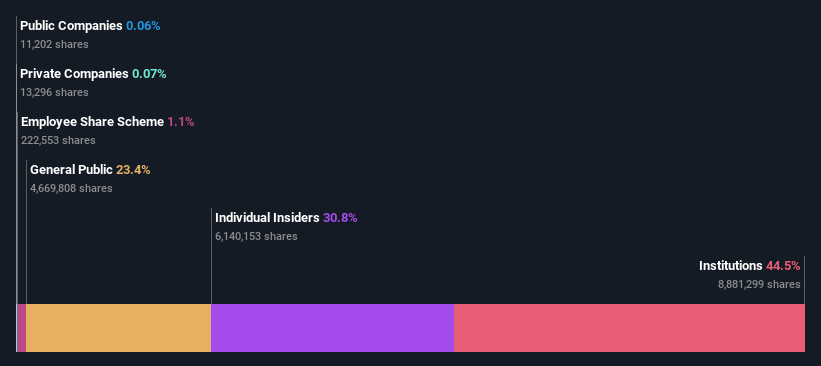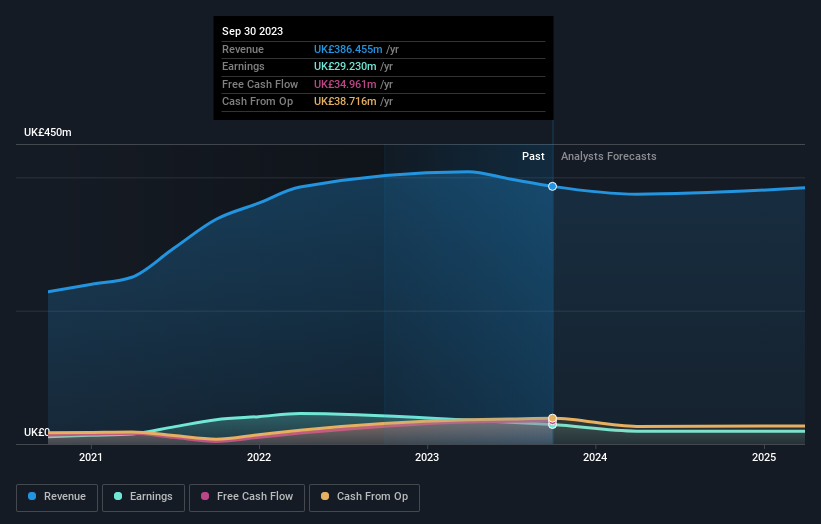Stock Analysis
- United Kingdom
- /
- Trade Distributors
- /
- AIM:LTHM
Recent uptick might appease James Latham plc (LON:LTHM) institutional owners after losing 9.5% over the past year

Key Insights
- Significantly high institutional ownership implies James Latham's stock price is sensitive to their trading actions
- 51% of the business is held by the top 8 shareholders
- Insiders own 31% of James Latham
A look at the shareholders of James Latham plc (LON:LTHM) can tell us which group is most powerful. With 45% stake, institutions possess the maximum shares in the company. In other words, the group stands to gain the most (or lose the most) from their investment into the company.
Institutional investors would appreciate the 11% increase in share prices last week, given their one-year returns have been disappointing at 9.5%.
In the chart below, we zoom in on the different ownership groups of James Latham.
See our latest analysis for James Latham

What Does The Institutional Ownership Tell Us About James Latham?
Institutions typically measure themselves against a benchmark when reporting to their own investors, so they often become more enthusiastic about a stock once it's included in a major index. We would expect most companies to have some institutions on the register, especially if they are growing.
We can see that James Latham does have institutional investors; and they hold a good portion of the company's stock. This implies the analysts working for those institutions have looked at the stock and they like it. But just like anyone else, they could be wrong. It is not uncommon to see a big share price drop if two large institutional investors try to sell out of a stock at the same time. So it is worth checking the past earnings trajectory of James Latham, (below). Of course, keep in mind that there are other factors to consider, too.

We note that hedge funds don't have a meaningful investment in James Latham. Peter Douglas Latham is currently the company's largest shareholder with 18% of shares outstanding. Quilter Cheviot Limited is the second largest shareholder owning 8.5% of common stock, and Close Asset Management Ltd. holds about 6.6% of the company stock.
We also observed that the top 8 shareholders account for more than half of the share register, with a few smaller shareholders to balance the interests of the larger ones to a certain extent.
Researching institutional ownership is a good way to gauge and filter a stock's expected performance. The same can be achieved by studying analyst sentiments. There is some analyst coverage of the stock, but it could still become more well known, with time.
Insider Ownership Of James Latham
While the precise definition of an insider can be subjective, almost everyone considers board members to be insiders. Management ultimately answers to the board. However, it is not uncommon for managers to be executive board members, especially if they are a founder or the CEO.
Insider ownership is positive when it signals leadership are thinking like the true owners of the company. However, high insider ownership can also give immense power to a small group within the company. This can be negative in some circumstances.
Our information suggests that insiders maintain a significant holding in James Latham plc. It has a market capitalization of just UK£219m, and insiders have UK£68m worth of shares in their own names. This may suggest that the founders still own a lot of shares. You can click here to see if they have been buying or selling.
General Public Ownership
The general public-- including retail investors -- own 23% stake in the company, and hence can't easily be ignored. This size of ownership, while considerable, may not be enough to change company policy if the decision is not in sync with other large shareholders.
Next Steps:
It's always worth thinking about the different groups who own shares in a company. But to understand James Latham better, we need to consider many other factors. Case in point: We've spotted 1 warning sign for James Latham you should be aware of.
If you are like me, you may want to think about whether this company will grow or shrink. Luckily, you can check this free report showing analyst forecasts for its future.
NB: Figures in this article are calculated using data from the last twelve months, which refer to the 12-month period ending on the last date of the month the financial statement is dated. This may not be consistent with full year annual report figures.
Valuation is complex, but we're helping make it simple.
Find out whether James Latham is potentially over or undervalued by checking out our comprehensive analysis, which includes fair value estimates, risks and warnings, dividends, insider transactions and financial health.
View the Free AnalysisHave feedback on this article? Concerned about the content? Get in touch with us directly. Alternatively, email editorial-team (at) simplywallst.com.
This article by Simply Wall St is general in nature. We provide commentary based on historical data and analyst forecasts only using an unbiased methodology and our articles are not intended to be financial advice. It does not constitute a recommendation to buy or sell any stock, and does not take account of your objectives, or your financial situation. We aim to bring you long-term focused analysis driven by fundamental data. Note that our analysis may not factor in the latest price-sensitive company announcements or qualitative material. Simply Wall St has no position in any stocks mentioned.
About AIM:LTHM
James Latham
Engages in the importing and distribution of timber, panels, and decorative surfaces in the United Kingdom, the Republic of Ireland, rest of Europe, and internationally.
Flawless balance sheet 6 star dividend payer.

